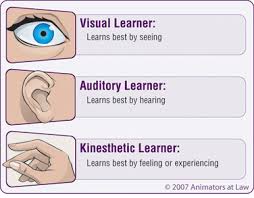Auditory learners are in every classroom. In fact, there are many types of learners in each and every classroom.
There are three basic types of learning styles – visual learners, auditory learners, and kinesthetic learners.
Visual learners make up about 40% of school-aged children. They benefit from diagrams, charts, pictures, films, and written directions. They love ‘to-do’ lists, assignment sheets, and notes. Visual learners have visual-spatial skills to reference sizes, shapes, textures, and angles. These learners also closely watch the body language of people around them and often use their hands when talking.
Kinesthetic and Tactile leaners learn best by moving and doing. These types of learners will take copious notes and never look at them later. They would rather draw or create a scene than write a formal book report. Kinesthetic students are hardly ever still and will move and travel about the classroom. Tactile-kinesthetic learners make up about five percent of the population. Auditory and visual learners also benefit from the strategies provided for the kinesthetic learners.
Most elementary classrooms focus on visuals and hands on materials but how does this affect the auditory learner? The auditory learner has the advantage in middle school and high school because of the lecture-type lessons. Middle school and high school students that are visual and kinesthetic learners are at a disadvantage.
With today’s focus on constructivist learning and problem based learning, we must recognize that the auditory learner may be at the disadvantage.
Auditory learners make up 20% of the population and may have sensitivity to both the presence of and the absence of sounds. I see these children as being misdiagnosed in the classroom because they learn through listening. They depend on hearing and speaking as the main way of learning. They do not write things down, they are quite happy singing (humming), or talking to those around them. Auditory learners have trouble with written assignments, tests, and silent activities. Difficulties lie in processing visual information. They are slower readers because they are challenged when they must process detailed written information. If they come across a graph, table, or other visual representations, they may require oral explanations. The task of learning a new language, writing an alphabet, or placing accent marks on words will prove demanding. They are good listeners but are anxious to talk. They thrive on class discussions, lectures, conversations, debates, and speeches.
You are an auditory learner if you struggle to remember what you’ve read, continuously write down information to remember, but have no problem providing the information acquired in a speech or a lecture. Auditory learners have several identifiable characteristics:
• Have astounding memories for former conversations
• Enjoy listening to music and have musical talents
• Have a preference for presentations that are oral
• Have strong language skills and a well-developed vocabulary
• Are well versed in communication skills
• Talk to themselves
• Are able to learn a foreign language with ease
• May be distracted by background noise
• Love being read to
• Whisper when reading out loud
The following strategies will help all types of learners, especially auditory learners to succeed in the classroom:
• Encourage them to ask questions
• Have them work in groups and group discussions
• Provide audio players for recording notes
• Provide videos for study purposes
• Repeat facts out loud
• Use mnemonic devices
• Use rhyming word games
• Study in groups
There is not a ‘one size fits all’ for a child’s learning style. Exploration of various methods and strategies of learning should be used for all children (differentiation). Each student has his own varied and preferred way of learning. For a simple test on which learner type you are, go to the website http://homeworktips.about.com/od/homeworkhelp/a/lstyleqz.htm for the article on a Learning Style Quiz. The basis of knowing each learner’s style will lead to improved academic success.
![]()



